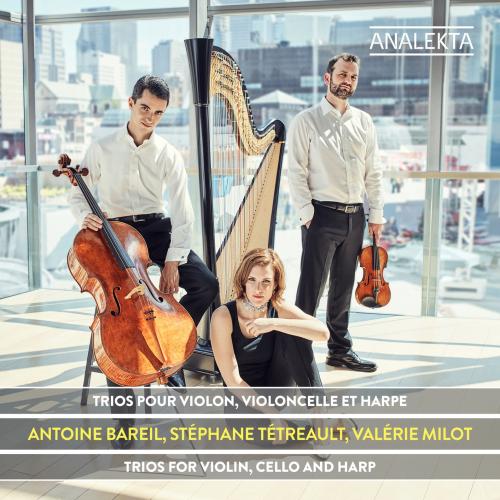
Trios for Violin, Cello and Harp Valérie Milot, Stéphane Tétreault & Antoine Bareil
Album info
Album-Release:
2017
HRA-Release:
24.01.2019
Label: Groupe Analekta, Inc
Genre: Classical
Subgenre: Chamber Music
Artist: Valérie Milot, Stéphane Tétreault & Antoine Bareil
Composer: Franz Schubert (1797-1828), Johan Halvorsen (1864-1935), Henriette Renie (1875-1956), Jacques Ibert (1890-1962)
Album including Album cover
- Jacques Ibert (1890 - 1962): Trio for Violin, Cello and Harp:
- 1 Trio for Violin, Cello and Harp: I. Allegro Tranquillo 06:01
- 2 Trio for Violin, Cello and Harp: II. Andante Sostenuto 06:33
- 3 Trio for Violin, Cello and Harp: III. Scherzando con moto 04:33
- Henriette Renié (1875 - 1956): Trio for Violin, Cello and Harp:
- 4 Trio for Violin, Cello and Harp: I. Allegro Risoluto 10:47
- 5 Trio for Violin, Cello and Harp: II. Scherzo: Vivace Scherzando 06:16
- 6 Trio for Violin, Cello and Harp: III. Andante 07:36
- 7 Trio for Violin, Cello and Harp: IV. Finale: Allegro 07:02
- Henriette Renié:
- 8 Danse des lutins 04:16
- Johan Halvorsen (1864 - 1935):
- 9 Passacaglia in G minor (after G.F. Handel’s Keyboard Suite No. 7 in G Minor, HWV 432 : VI. Passacaille) 07:25
- Franz Schubert (1797 - 1928):
- 10 Lob der Tränen, S.557/R.242 03:47
Info for Trios for Violin, Cello and Harp
Harpist Valérie Milot is like a hummingbird, delighting you with each appearance, and before you know it, moving on to the next thing.
Focused primarily on French music from the first half of the 20th century, this album reveals the subtle blend of sonorities formed by the harp, cello, and violin through the trios of Jacques Ibert and Henriette Renié. The exploration of this period continues with Danse des lutins, an acrobatic work for harp by Renié. Antoine Bareil and Stéphane Tétreault then perform the dazzling, encore-worthy Passacaglia for violin and cello by Handel/Halvorsen, before Valérie Milot re-joins the trio for a sweet, introspective finale in the form of a Schubert lied arranged for these forces.
Not all record labels will greenlight such obscure repertoire. "My history with Analekta has always been in tune with my aspirations," Milot tells us. "They've been supportive since the beginning of my career and considered my discography as an ensemble with elements that enlighten different aspects of my career — solo, chamber music, different styles and eras, etc. I’m glad they are open to crazy ideas."
As with many of Milot's projects, this one is not only a bit crazy, but also highly personal — a collaboration with her husband, violinist Antoine Bareil, and her longtime friend, cellist Stéphane Tétreault. "Stéphane is one of those great musicians with no filter between the person he is in real life and the artist he is onstage," reflects Milot. "The channel is always broad and pure!"
Their complicity is apparent from the outset in Ibert's Trio for Violin, Cello and Harp. He composed it in 1944 for his daughter Jacqueline, a harpist, who promised her father cigarettes (scarce in war-torn France) in return for the work.
The nicotine evidently worked wonders. "Ibert’s trio is a gem of subtleties and details, like a beautiful piece of lace," reflects Milot, who enjoyed the challenge of working on such complex music with Bareil and Tétreault. "The three movements are quite different — I have a soft spot for the second."
The combination of violin, cello and harp isn't all that common, and cellist Tétreault feels the harp contributes to an especially intimate sound. "The colours and ambiances are stunning and delicate," he tells us. "The variety of sound is also great, as it is possible to achieve a certain 'percussive' quality with a harp, perhaps even more so than with a piano."
Antoine Bareil, violin
Stephane Tetreault, cello
Valerie Milot, harp
No biography found.
This album contains no booklet.







